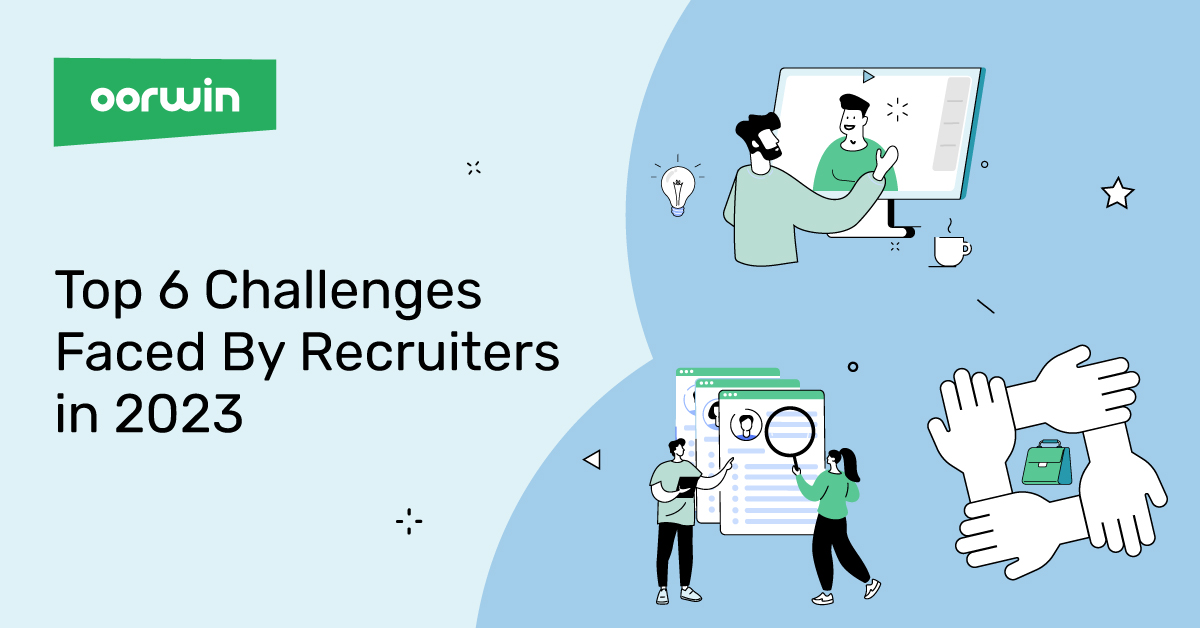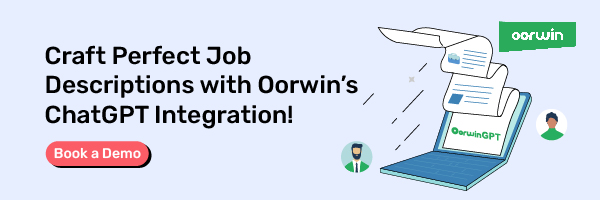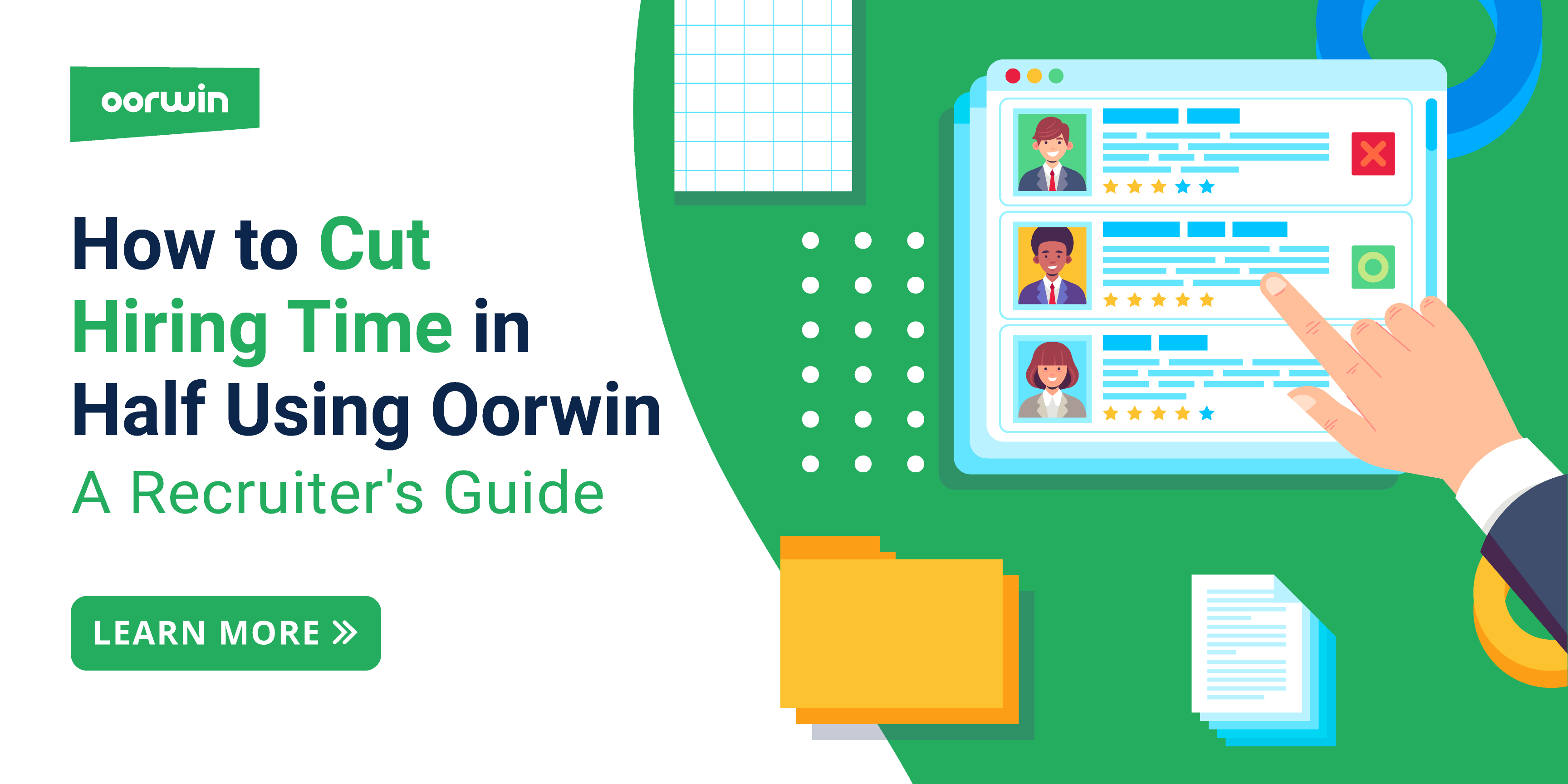Top 10 Challenges Faced By Recruiters in 2024 & Effective Solutions
Oorwin
8min read / 15 Jul 2022

Related Articles
Understanding Recruitment Challenges in 2024: Key Strategies & Solutions
As a recruiter, you’re expected to find qualified candidates to place into available roles that match their experience, skills, and background. You must also attend meetings, check references, collect documents, and maintain relationships with the company or client. Several recruitment challenges are faced.
Recruiting teams must quickly adapt, refine processes, and create new ones to make interviewing and hiring work through any channel. 70% of professionals agree virtual recruiting is becoming the new standard. Embracing technology is essential, as tools like CRM platforms can significantly streamline the hiring process, cutting down hiring time by up to 40%. This approach not only enhances efficiency but also ensures a more effective talent acquisition strategy in the face of evolving recruitment challenges.
Evolving Role of Recruiters in the Digital Era
Recruiters play an essential role in connecting employers and employees. They are responsible for conducting interviews and assessing prospective candidates, providing feedback and guidance to managers, and educating the organization about best practices for recruitment and retention. Furthermore, recruiters must ensure that the organization makes the most of its talent pool by focusing on diversity, inclusion, and fair and equitable diversity practices.
Recruitment challenges faced by recruiters often revolve around the evolving role of recruiters. Their role, central to conducting interviews and evaluating candidates, has evolved into strategic advisory, emphasizing diversity and inclusion to enrich the talent pool. As technology simplifies tasks, their focus shifts towards relationship-building, cultural fit assessment, and data-driven decision-making. Adapting to these changes, recruiters remain crucial in the recruitment process, skillfully navigating the dynamic landscape of talent acquisition. Their expertise now blends technological proficiency with a nuanced understanding of a diverse workforce’s needs.
10 Key Recruitment Challenges Faced by Recruiters in 2024 and Their Solutions
Recruiters today encounter diverse challenges, ranging from digital transformation to improving candidate experiences. This section delves into key challenges and their practical solutions.
1. Remote Candidate Sourcing
Traditional recruiting methods, like job fairs, are only one effective way to source candidates. Recruiters need fast recruitment methods to source the best talent possible. This can be a significant recruitment challenge in talent acquisition for several reasons, including increasing candidate skills gaps. As a recruiter, you’ll be sifting through candidates who don’t have the necessary skills for the job.
How to overcome this recruitment challenge?
Recruitment technology virtually (no pun intended) eliminates the hassles of in-person recruiting or manual job board data entry:
Virtual recruitment is highly effective when used with communication platforms like Microsoft Teams and Slack. Tools like video chat platforms and applicant tracking systems are excellent ways to conduct interviews and gather online assessments.
In addition to fully remote recruiting, adopting a hybrid recruitment model can further enhance talent acquisition. This approach combines traditional in-person methods with digital strategies, offering flexibility and a broader reach in sourcing candidates. It caters to diverse candidate preferences and adapts to varying global work cultures.
Digital candidate sourcing and matching technology expedite recruitment processes like never before. An ATS can even be integrated with job boards.
An HRMS (human resource management system) bridges the skills gap by offering customizable training and learning modules and mentorship opportunities for candidates of all skill levels and helps in alleviating the challenges faced by recruiters.
2. A Poor Candidate Experience
Creating a positive candidate experience is not one of the newer challenges in the recruitment process. However, it has become more complex with the increase in virtual recruiting. Focusing on improving the candidate experience is vital because, According to a recent statistics report by Finances Online, 75% of newly hired employees say a positive experience influenced their eventual acceptance of the job.
How to overcome this recruitment challenge?
The beauty of virtual recruitment tools is that they can make everything, from harvesting candidate resumes to requesting interviews, an automated, streamlined experience. It also promotes transparent communication, which is a great stress reliever for candidates in minimizing recruitment challenges.
Here are a few other ways technology improves the candidate experience:
- An Applicant Tracking System can quickly connect qualified candidates with open jobs, saving candidates from unnecessary interviews or paperwork.
- A digital hiring management system can automate interview scheduling with the click of a button. This fast-tracks interview scheduling and assessment requirements without any back and forth.
- In turn, integrated interview feedback tools provide automatic feedback quickly, saving considerable time and stress for candidates and hiring managers.
- Furthermore, leveraging AI-driven chatbots for initial interactions and queries enhances responsiveness, making candidates feel valued from the outset. This integration of AI in the recruitment process not only streamlines operations but also significantly boosts the overall candidate experience.
3. Making Data-based Recruiting Decisions
Most recruitment challenges recruiters face are how they need help to analyze data in a way that gives hiring managers options they can act on due to the unavailability of required tools—trusting your instincts when hiring is the biggest challenge faced in talent acquisition.
How to overcome this recruitment challenge?
Make the most of Al and automation in hiring. Recent advancements in Artificial Intelligence (AI) have revolutionized the recruitment process. Artificial intelligence (AI) can be programmed to filter a sizable pool of applicants and only suggest those that pass the screening to the hiring team.
One can also use predictive analytics to keep ahead of the competition or talent war. By analyzing the data of current employees, recruiters can learn what to look for (or watch out for) in future hires. This includes using sophisticated algorithms to predict candidate success and fit, thereby enhancing the quality of hires. Additionally, AI-driven analytics can now provide deeper insights into candidate behavior and preferences, enabling a more targeted recruitment approach.
4. Overcoming Discrimination in Hiring
To choose the best candidate for the job, a company must provide all candidates equal opportunity. Additionally, it is required by law and is an excellent method to interact with others without discrimination. Implicit biases are one of the reasons for recruitment challenges and why many organizations find hiring candidates from diverse backgrounds difficult. By conducting objective hiring, your company will benefit from an inclusive staff and the right candidate for the job.
How to overcome this recruitment challenge?
Given the advent of hybrid recruiting, the most straightforward answer is to involve other team members in in-person or electronic interviews. ATS also has integrations with video-interviewing platforms to make recruitment more accessible.
Employees always view candidates somewhat differently than recruiters do. They might see things that recruiters miss, such as hidden personality defects. Use personality tests to weed out biases so decisions are based on data instead of preferences.
Additionally, emphasizing Diversity and Inclusion (D&I) in recruitment strategies is increasingly important. This involves crafting inclusive job ads, seeking varied candidates, and using fair screening methods. Educating recruiters on D&I helps reduce biases.
5. Unclear Job Descriptions
Unclear job descriptions are a common issue for job seekers and can affect the caliber of applicants. These descriptions should be clear and comprehensive, detailing the role and its responsibilities. Vague job postings often get overlooked by qualified candidates.
Additionally, unclear descriptions may attract unsuitable applicants. If criteria aren’t specified, unqualified individuals might apply, leading to excessive resume screening and longer hiring times.
How to Overcome This Recruitment Challenge?
To improve job descriptions:
- Clearly state essential qualifications. For instance, specify required programming languages for web developer roles.
- Define job performance metrics, like article quotas for writers or sales targets for executives.
- List both technical and interpersonal skills needed, such as communication and problem-solving, for client-facing roles.
- Disclose the salary range. This transparency can attract candidates and reflects a culture of open communication.
Discover the ease of crafting compelling job descriptions with Oorwin’s ChatGPT integration. Explore this innovative tool now and revolutionize your recruitment process!
6. Building a Strong Employer Brand
A critical recruitment challenge is establishing and maintaining a robust employer brand. A positive employer brand is crucial for attracting and retaining top talent. It encompasses various facets, from delivering a positive candidate experience to showcasing company culture on social media. It demands a collective effort and buy-in from within the organization.
How to overcome this recruitment challenge?
To address this challenge, organizations should actively engage in the following strategies:
- Respond to Online Reviews: Promptly and courteously respond to both positive and negative online reviews. This demonstrates transparency and a commitment to addressing concerns.
- Empower Your Team: Provide your employees with the tools and platforms to share their own experiences and stories about their work. Encourage them to contribute through blogs, videos, or social media, giving prospective candidates a genuine look at the company culture.
- Be a Great Employer: Ultimately, the best way to build a strong employer brand is to be a great employer. This involves fostering a positive work environment, offering competitive benefits, and prioritizing employee well-being.
- Showcase Career Development Opportunities: Highlight the career progression and learning opportunities available within your organization. This can include mentorship programs, training sessions, or pathways for advancement that attract prospective employees.
7. Lengthy Time-to-Hire
Hiring quickly is a priority for organizations, as prolonged vacancies incur costs and disrupt operations. However, in some industries, the hiring process can extend over several months, creating pressure on recruiters and causing the loss of top candidates. This delay is a cause of an impending recruitment challenge, which may result from a shortage of qualified applicants, an unnecessarily lengthy hiring process, or challenges in reaching a consensus among hiring teams.
How to overcome this recruitment challenge?:
To address the recruitment challenge of lengthy time-to-hire, organizations should consider the following:
- Streamline the Hiring Process: Evaluate the necessity of each hiring stage and make it more efficient. Leverage data and insights from your Applicant Tracking System (ATS) to identify bottlenecks and optimize the process.
- Set Realistic Expectations: Communicate openly with hiring teams about the nature of hard-to-fill roles, acknowledging that a longer hiring timeline may be unavoidable. Stress the importance of making informed decisions for critical positions, even if it takes additional time.
- Implement Accelerated Interview Schedules: Reduce the time-to-hire by scheduling interviews more efficiently. Consider grouping interviews on specific days or using back-to-back interview slots to speed up the decision-making process. This approach helps in quicker candidate evaluation and reduces the overall hiring duration.
- Enhance Candidate Engagement: Keep candidates engaged throughout the hiring process with regular updates and feedback. This approach helps maintain their interest and reduces the likelihood of losing them to other opportunities. Effective communication can also create a positive impression of the organization, making it more attractive to potential hires.
8. Prioritizing Diversity and Inclusion
Demand for equity and inclusion in the workplace is louder than ever. Steps have been made in the right direction, but progress has been slow, leaving D&I as one of the most significant recruitment challenges. However, companies are finally accepting and addressing this issue-:
- 77% of talent professionals agree that recruiting culture must prioritize diversity.
- 47% say hiring managers need to be held accountable for interviewing a diverse pool of candidates.
- 3 out of 4 American job seekers selectively seek out companies that are outspoken about empathy, diversity, and breaking down discrimination barriers.
How to overcome this recruitment challenge?:
As a recruiter, you can set an example and catalyze change. Technology, like an applicant tracking system, can help recruiters do this in a few ways:
Rethink existing recruiting and hiring processes – diverse interview panels will help recruiters hold each other accountable. Data-based reporting can help keep recruiters on track to their diversity goals.
It allows you to combine recruiting trends using talent analytics and reporting methods. This helps you determine where hiring biases have been the most prevalent. In turn, it enables you to avoid following this same pattern.
An applicant tracking system (ATS) also helps reduce bias by utilizing a specific set of metrics in recruitment. By using artificial intelligence and relying on data, you eliminate the risk of human bias.
9. Standing Out in a Volatile Market
In the recruitment space, there’s always discussion about whether it’s an employer’s or a candidate’s market. While most assume that the current recession means it’s an employer’s market, leaning back on this mindset will cause recruiters to miss out on key talent that will bring in and boost revenue. While this is one of the less apparent recruitment challenges faced, it remains one of the most impactful.
How to overcome this recruitment challenge?
Recruiters must navigate a dynamic job market where candidates are increasingly selective. To effectively attract and retain top talent, consider these strategies:
- Utilize AI-powered Applicant Tracking Systems for efficient, accurate candidate matching.
- Leverage keyword analysis to identify top talent in resource pools.
- Be flexible with job roles and compensation to adapt to market trends.
- Build a strong employer brand and enhance employee value propositions.
- Develop a talent pipeline and maintain relationships with potential candidates.
- Focus on skills and potential over experience to access a broader talent pool.
- Use proactive strategies for quicker hiring, reducing time and costs
As an AI-enabled platform, Oorwin takes care of all the challenges mentioned above. Sign up for a free trial to solve them today.
- Low Offer Acceptance Rate
A low offer acceptance rate indicates an organization is losing out on fitting candidates who have successfully navigated the recruitment process. When a job offer is declined, it not only wastes the time and resources invested in the hiring process but also reflects on the employer’s brand value or company culture. Sometimes, candidates opt out for better opportunities, highlighting areas where the organization might need improvement.
How to Overcome This Recruitment Challenge?
To tackle this issue, it’s essential to:
- Reassess the compensation structure against industry standards and consider the overall value offered to employees. It’s crucial to understand that factors beyond salary can influence a candidate’s decision.
- Reflect on your employer brand. Gauge how your organization is perceived in the market and what you can do to enhance its appeal.
- Consider insights similar to those from employer branding studies, which reveal that business school graduates often prioritize career progression and growth opportunities over salary and benefits. Aspects like work-from-home options, relocation opportunities, and training programs tend to be less influential in their decision-making process.
- Leveraging social media not only for sharing information but also for assessing and shaping public perception of your company. Social media serves as a vital tool for understanding how your organization is perceived and for implementing changes to enhance its image.
Revolutionize Your Recruitment Strategy with Oorwin
Overcoming recruitment challenges is crucial for any business aiming to thrive in today’s competitive landscape. Oorwin’s AI-enabled platform provides innovative solutions, streamlining the talent acquisition process. It efficiently addresses key challenges such as candidate sourcing, engagement, and diversity hiring, ensuring a smoother, more effective recruitment journey. With Oorwin, businesses can enhance their recruitment strategies, leading to better hiring outcomes and overall organizational success.
Ready to transform your recruitment process? Try Oorwin today and experience the difference in talent acquisition efficiency. Sign up for your free trial now.
Frequently Asked Questions
What are the main challenges in recruitment in 2024?
The most common challenges recruiters face are talent shortage, more passive candidates, increased competition, inefficient recruitment processes, and Lack of employer brand and talent pools.
What are 5 recruitment strategies?
5 strategies for attracting outstanding talent:
- Make a candidate persona for roles that are difficult to fill.
- Ensure a smooth application process.
- Create a program that encourages employee referrals.
- Attempt to lessen bias.
- Recognize what talent seeks.
How do you handle recruitment challenges?
- Change from a reactive to a proactive strategy.
- Make the candidate experience consistent.
- Create a culture of hiring.
- Recruiting metrics can be used to find areas that need improvement.
- Obtain feedback from hiring managers and candidates.
- Consolidate the technology of recruitment.
How does Oorwin aid in overcoming these recruitment challenges?
Oorwin helps overcome recruitment challenges by:
- Providing AI-powered tools for efficient candidate sourcing and screening.
- Offering an integrated platform for streamlined recruitment processes, combining ATS functionalities with other recruitment tools.
- Enhancing candidate engagement and experience through advanced technology.
- Facilitating data-driven decision-making to improve recruitment outcomes.
- Supporting diversity and inclusion initiatives in talent acquisition.
Popular Articles..
Blog

6min read / 25-Jun-2025
Master Effective Interview Techniques with Oorwin: A Step-by-Step Recruiter’s Guide
Blog
Blog
Get the latest Oorwin releases, updates, success stories & industry news
 Back
Back


